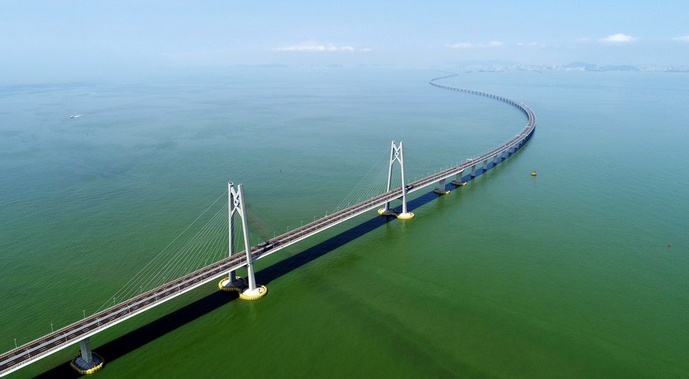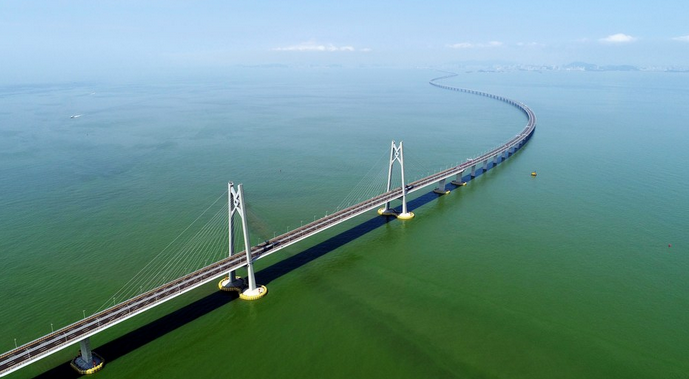
Aerial photo taken on July 11, 2018 shows the Hong Kong-Zhuhai-Macao Bridge in south China. (Xinhua/Liang Xu)
BEIJING, May 20 (Xinhua) -- As one of the regions with the highest degree of openness, the strongest economic vitality, and the leading international level in China, the Guangdong-Hong Kong-Macao Greater Bay Area (Greater Bay Area) accelerates its infrastructure construction and the flow of essential resources such as materials, funds, and information, and promotes its opening-up and sharing levels, entering a new phase of accelerated integration.
The quick development of economy in Greater Bay Area is backed by the fast-gathered power of innovation. In recent years, the Greater Bay Area has taken full advantages of its local industries to optimize urban collaboration, activate innovation potentials, empower talent development, attracting more talents to the region.
-- New phase of accelerated integration of the Greater Bay Area
Since the outline development plan for the Greater Bay Area unveiled by Chinese authorities on February 18, 2019, the Greater Bay Area entered into the new phase of accelerated integration with astonishing speed. Its gross domestic product reached 11.5 trillion yuan in 2020, up 1.4 trillion yuan from 2017.
In more than two years, the Greater Bay Area has attached importance to the infrastructure construction. With the completion of landmark projects such as Hong Kong-Zhuhai-Macao Bridge and Guangzhou-Shenzhen-Hong Kong Express Rail Link, the diversified stereo-traffic network covering 11 cities of the Greater Bay Area was further densified and the "one-hour life circle" was basically formed.
Meanwhile, the synergy effect of the airport cluster and port cluster of the Greater Bay Area was constantly strengthened. Currently, the annual passenger throughput of the Greater Bay Area's airports exceeds 200 million passengers, and the port container throughput exceeds 80 million TEUs, both ranking the first among the four major bay areas in the world.
Under Closer Economic Partnership Arrangement (CEPA), Guangdong Province has basically realized free trade and service with Hong Kong and Macao. Enterprises of Hong Kong and Macao may enjoy national treatment in investing in areas like law, accounting and construction. In recent three years, Guangdong newly introduced over 50,000 enterprises invested by Hong Kong and Macao, with an actual utilized funds of over 340 billion yuan.
In addition, the interconnection of financial markets in the Greater Bay Area is progressing in an orderly manner, said Ma Xingrui, governor of Guangdong. The first Guangdong-Macao cooperative fund with the volume of 20 billion yuan has invested 18.4 billion yuan to support 23 key projects. So far, 276 Guangdong enterprises have been listed in Hong Kong and over 200 financial institutions of Hong Kong and Macao have set their branches in Guangdong.
-- Innovation quickens the "flow" within the Greater Bay Area
With the level of opening-up and sharing constantly improving, the "soft interconnection" including the flow of top talents and innovative resources was also accelerating.
Cities in the Greater Bay Area have also issued a series of policies to attract high-level talents and improve their security measures for talent services. Focusing on solving hotspot issues like talent settlement, housing, education for children and entry and exit of the border, Guangdong has attracted lots of talents and high-tech projects to settle in the province. Statistics showed that in recent years, talents from Hong Kong, Macao and Taiwan who come to Guangdong for work and exchange reached 230,000 averagely per year, ranking the first in China.
The co-construction and sharing of scientific and technological facilities and scientific instruments has become an important channel for connecting the basic research forces of Guangdong, Hong Kong and Macao and attracting the flow of basic research talents.
To support scientific research institutions of Hong Kong and Macao to participate in major scientific and technological plans of Guangdong, the province shared over 10,000 large scientific and technological instruments with Hong Kong and Macao and appropriated accumulatively 150 million yuan for scientific researches by simplifying the procedures for cross-border usage and import & export of R&D products.
In education, medicine and other areas concerning people's livelihood, Guangdong also actively introduced relevant fine resources for public service from Hong Kong and Macao. Hong Kong University of Science and Technology (Guangzhou) has already started construction and 35 medical organizations from Hong Kong and Macao set up offices in Guangdong, with the permission to use the medicines and medical equipment already marketed in Hong Kong and Macao.
-- Shenzhen sets up global platform for talent communications
Recently, the Flow Index of Four Major Global Bay Areas (2020-2021) was released and Shenzhen ranked the 6th in terms of the comprehensive index of element resource flow, ranking behind New York, Tokyo, Hong Kong, San Jose and San Francisco, with its scores improving greatly from last year. It also has absolute advantages in terms of the container handling capacity of ports, export dependence, number of PCT international patent applications, etc.
As the core engine of the Greater Bay Area, Shenzhen is accelerating full integration with Hong Kong and Macao. Focusing on modern financial services, Shenzhen facilitated investors from Hong Kong and Macao in establishing businesses and launched 90 system innovations including improving mutual professional recognition with Hong Kong and Macao.
Besides, Shenzhen also reconstructed its talent policy framework in a systematic manner. Currently Shenzhen has in total 6 million of different talents, with over 2 million of sci-tech talents. Based on the global platform for innovative and creative communications between young talents, Shenzhen established the entire circle covering talent introduction, cultivation, incentive and output and promoted the development of overseas talents in the Greater Bay Area. Now, Shenzhen has over 150,000 returned talents after studying abroad.
Because of the gathering of elite talents and constant improvement of innovation ability, Shenzhen achieved an outstanding performance last year in coordinating pandemic prevention and control as well as social and economic development. Shenzhen's social investment in R&D accounted for 4.93 percent of its regional GDP, reaching global leading level and its added value in strategic emerging industry exceeded 1 trillion yuan, up 3.1 percent, and accounting for 37.1 percent of regional GDP.
(Edited by Gao Jingyan with Xinhua Silk Road, gaojingyan@xinhua.org)




 A single purchase
A single purchase









